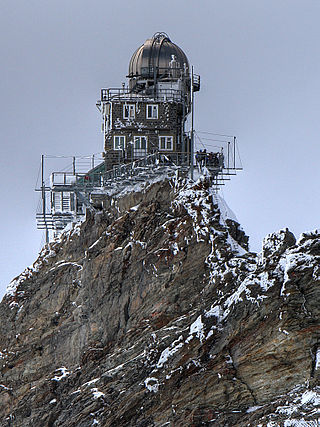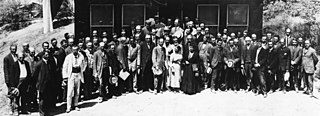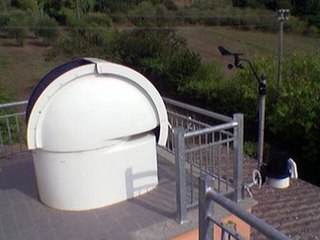
An observatory is a location used for observing terrestrial, marine, or celestial events. Astronomy, climatology/meteorology, geophysics, oceanography and volcanology are examples of disciplines for which observatories have been constructed. Historically, observatories were as simple as containing an astronomical sextant or Stonehenge.

The San Vittore Observatory is an astronomical observatory in Bologna, Italy. In the years from 1975 to 1981 the San Vittore Observatory (Bologna) Italy participated to the International Planetary Patrol Program.Following it has made numerous asteroid discoveries during 1980–2000.
Paolo Chiavenna is an Italian amateur astronomer and a co-discoverer of minor planets, credited by the Minor Planet Center with the discovery of 15 minor planets during 1995–2000.
The Santa Lucia Stroncone Astronomical Observatory is an astronomical observatory located at 350 metres (1,150 ft) altitude in Stroncone, near the city of Terni, in Umbria, north central Italy.

The Vatican Observatory is an astronomical research and educational institution supported by the Holy See. Originally based in the Roman College of Rome, the Observatory is now headquartered in Castel Gandolfo, Italy and operates a telescope at the Mount Graham International Observatory in the United States.

The University of Catania is a university located in Catania, Sicily. Founded in 1434, it is the oldest university in Sicily, the 13th oldest in Italy, and the 29th oldest university in the world. With a population of over 60,000 students, it is the main university in Sicily.

The Asiago Astrophysical Observatory is an Italian astronomical observatory owned and operated by the University of Padua. Founded in 1942, it is located on the plateau of Asiago, 90 kilometers northwest of Padua, near the town of Asiago. Its main instrument is the 1.22-meter Galilei telescope, currently used only for spectrometric observations.
The Cagliari Observatory is an astronomical observatory owned and operated by Italy's Istituto Nazionale di Astrofisica. It is located 20 km away from Cagliari in Sardinia. It was founded in 1899 to study the Earth's rotation.

The Monte Mario Observatory is an astronomical observatory and is administratively part of the Observatory of Rome. It is located atop Monte Mario, near the right bank of the river Tiber, in the municipality of Rome, Italy. This location was used as the prime meridian for maps of Italy until the 1960s.

The Collurania Observatory, also Teramo Observatory,, is an astronomical observatory located in Teramo, in Abruzzo region of central Italy. It was founded by Vincenzo Cerulli in 1890, who was later honoured by having it bear his name. The observatory is owned and operated by the National Institute for Astrophysics (INAF). It has the IAU code 037.

The Observatory of Turin is an astronomical observatory owned and operated by Italy's National Institute for Astrophysics. It is located on the top of a hill in the town of Pino Torinese near Turin, in the north Italian Piedmont region. The observatory was founded in 1759. At Pino Torinese, several asteroid discoveries were made by Italian astronomer Luigi Volta in the late 1920s and early 1930s. The asteroid 2694 Pino Torinese was named after the observatory's location.

Astronomical Observatory of Trieste is an astronomical center of studies located in the city of Trieste in northern Italy.

The Pistoia Mountains Astronomical Observatory, also known as the San Marcello Observatory and the Pian dei Termini Observatory, is an astronomical observatory in San Marcello Piteglio, Tuscany, central Italy.

Annibale Riccò was an Italian astronomer.

Monte Porzio Catone is a comune (municipality) in the Metropolitan City of Rome in the central Italian region of Latium, located about 20 kilometres (12 mi) southeast of Rome, on the Alban Hills.

The National Institute for Astrophysics is an Italian research institute in astronomy and astrophysics, founded in 1999. INAF funds and operates twenty separate research facilities, which in turn employ scientists, engineers and technical staff. The research they perform covers most areas of astronomy, ranging from planetary science to cosmology.

The Gnosca Observatory is an astronomical observatory at Gnosca, Ticino, Switzerland. It is owned and operated by amateur astronomer Stefano Sposetti and has the observatory code 143. At Gnosca Observatory, Stefano Sposetti has discovered numerous minor planets (also see Category:Discoveries by Stefano Sposetti).

The Cima Ekar Observing Station is an astronomical observatory on the crest of Cima Ekar, a mountain ridge located approximately 4 kilometers southeast of and 350 m higher than the town of Asiago, Italy.

Oriolo Romano Observatory is an amateur astronomical observatory in Oriolo Romano, Viterbo, Italy. Built in 2007, the observatory has a Celestron 8" Schmidt-Cassegrain F/10 telescope. The observatory was designed to be fully robotic, uses a QSI WS40 CCD camera with clear filter for data acquisition. The observatory is only used for astronomical research and educational outreach. Website contains a guide to universities in the United States and in Italy specialized in physics, astrophysics and astronomy.

The Giuseppe S. Vaiana Astronomical Observatory is an astronomical observatory located in Palermo, Sicily, Italy, housed inside the Palazzo dei Normanni. It is one of the research facilities of the National Institute of Astrophysics. The observatory carries out research projects in the field of astronomy and astrophysics including the study of solar and stellar coronas, stellar evolution and of the supernova remnants.


















